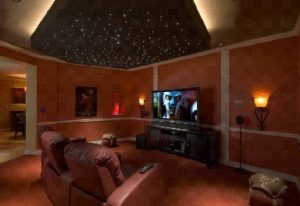Two-piece projection systems put the WOW in your home theater system.
 Even though flat-panel displays get a lot of attention today, they can’t contend with home theater Miami front-projection systems when your ultimate goal is to have a truly captivating home theater in Miami . As self-evident as it may seem, home theater Miami is all about building a theater … in your home. How many times have you gone to a movie theater to find that everyone is huddled around a 50-inch LCD? (If your answer was “greater than zero,” you should find a new movie theater.)
Even though flat-panel displays get a lot of attention today, they can’t contend with home theater Miami front-projection systems when your ultimate goal is to have a truly captivating home theater in Miami . As self-evident as it may seem, home theater Miami is all about building a theater … in your home. How many times have you gone to a movie theater to find that everyone is huddled around a 50-inch LCD? (If your answer was “greater than zero,” you should find a new movie theater.)
You don’t say WOW about a flat panel, but if you walk into a room with a 110-inch screen and a gigantic football game is playing on it, you would say WOW! There’s nothing like a two-piece projector and home theater Miami screen system to give you that WOW factor.
Bigger is Better
The biggest thing a home theater Miami front-projection system has going for it is size. When looking for a canvas on which to boast your favorite films, sporting events, television shows, and home movies, sheer screen size can go a long way toward turning an average Saturday night into an affair. Flat-panel displays are typically measured in inches, whereas home theater Miami front projection screens are measured more easily in feet. For example, a 124-inch (diagonal) screen, which features a 16:9 HDTV aspect ratio, measures an extraordinary 9 feet wide. That’s big!
Although home theater Miami front-projection systems offer much larger screen sizes, you don’t necessarily pay more for this privilege. Inch for inch, a front projector and screen is much more cost-effective. Who wouldn’t want a big 120-inch image for about the same price as a 65-inch flat-panel display?
How It Works
When you break it down, a home theater Miami front-projection system is really quite straightforward. As the name suggests, the screen displays an image that’s being projected from the front. This is in opposition to rear-projection televisions (RPTVs), which are TVs where a projection mechanism is inside a cabinet and using a mirror an image is projected onto the screen from the rear.
With a home theater miami front-projection system, both the projector and screen are important components to the picture quality. All of the devices you would want to connect to a traditional TV can also be connected to a home theater Miami projection system. However, doing so does require a bit of planning to establish that all of the video sources are switched properly and that a home theater Miami speaker system can handle the audio portion of the signal. The basic wiring of the home theater Miami system will differ little from what you already have.
Projector Choices
Like flat-panel displays, home theater Miami video projectors are available from a variety of manufacturers and use a multitude of different display technologies. You usually have to choose between plasma and LCD with flat panels, the latter of which includes the popular sub-category of LED TVs. You also have choices when shopping for a home theater Miami front projector. These days, practically every home theater Miami projector offers high-definition support, HDMI and component video is the most common connection options. Projectors tend to differ because of the technologies they use to create the images.
DLP (Digital Light Processing) and LCD serve as the two most common types of front projectors. The LCD variant known as LCoS (Liquid Crystal on Silicon) stands as another popular option. LCoS is mainly used by JVC and Sony, who have each developed proprietary implementations of this technology, which they call D-ILA and SXRD.
We Make House Calls
Request a proposal or call (561) 624-0220 to speak to one of our home electronics specialists.
Call now
Get In Touch
- 430 Toney Penna Dr Suite #1 Jupiter, Florida 33458
- (561) 624-0220
- [email protected]
- Monday – Friday : 8:30AM–5PM Saturday, Sunday: By Appointment
